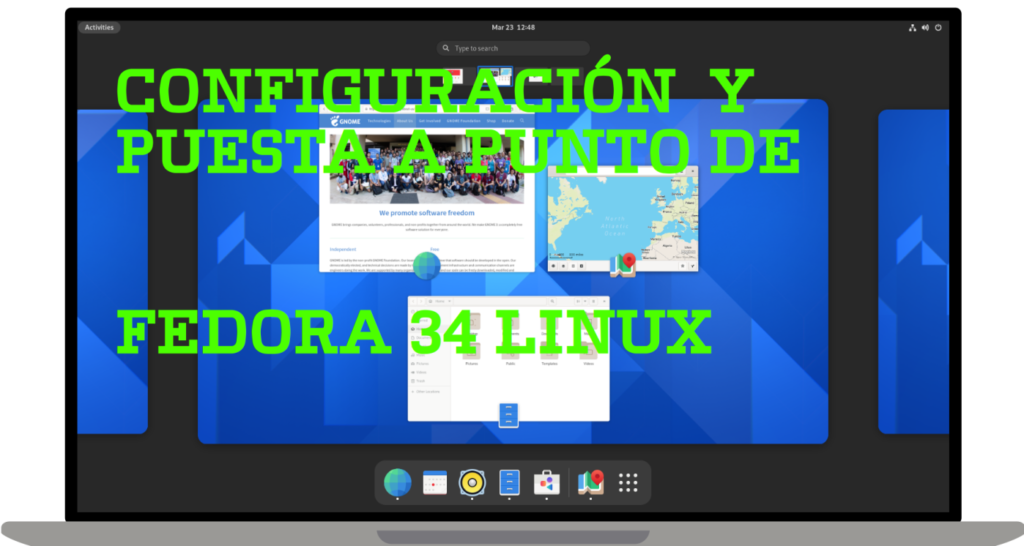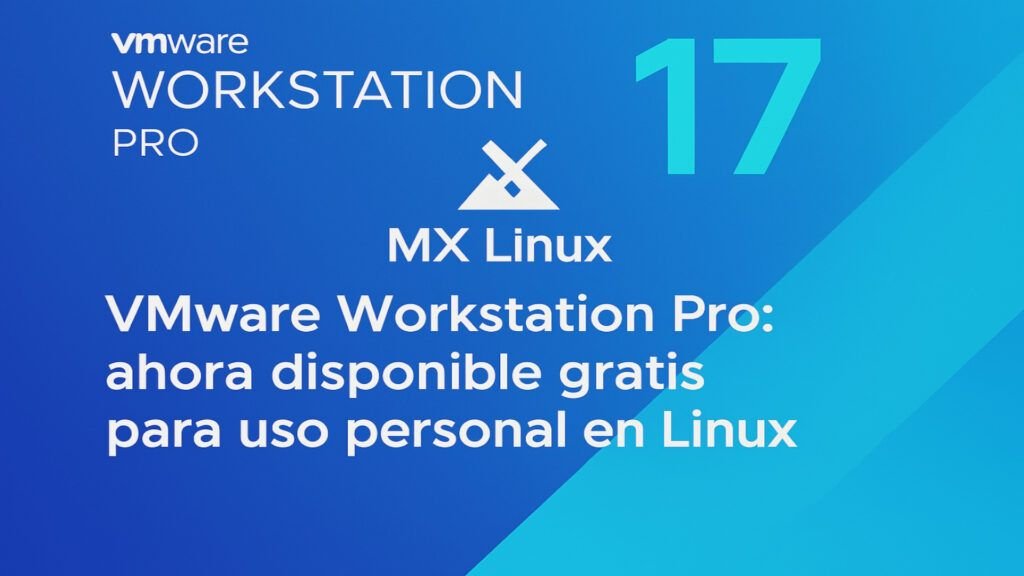
1. Introduction
VMware Workstation Pro It is one of the most popular virtualization solutions for developers, system administrators, and advanced users. It allows you to run multiple virtual machines (VMs) with different operating systems on a single physical computer, facilitating testing, development, and isolated environments.
In this document, we will explore VMware Workstation Pro 17, its history, key features, supported operating systems, and how to install it on Debian 12 (Bookworm). Although VMware is not a free software application, but proprietary, but it is free for personal use on Windows, Mac and Linux and I think it is an excellent operating system virtualizer with high quality for companies, system technicians and developers, in the past it was paid for both companies and individuals and we had the option of the extinct VMware Player free for individuals.
2. What is VMware?
VMware is a leading virtualization solutions company. Its software enables the creation and management of virtual machines (VMs), providing a secure and flexible environment for running different operating systems on the same hardware.
2. History of VMware Workstation Pro
- 1999: VMware releases its first version for Linux.
- 2001: VMware Workstation 3.0 introduces support for Windows.
- 2014: VMware Workstation 11 adds Windows 10 support and performance improvements.
- 2022: VMware Workstation Pro 17 arrives with support for Windows 11, TPM 2.0, DirectX 11 and OpenGL 4.3, in addition to improvements in nested virtualization.
3. VMware Workstation Pro Features 17
- Free license: Now available free of charge to all users.
- Nested virtualization: Run hypervisors inside a VM (useful for Hyper-V, Docker, etc.).
- Support for Windows 11: Requires virtual TPM and Secure Boot.
- Graphics improvements: Support for DirectX 11 and OpenGL 4.3.
- Advanced Snapshots: Save and restore virtual machine states.
- Container support: Integration with Docker and Kubernetes.
- Encrypted VMs: Enhanced security with AES-256 encryption.
- Support for USB 3.1 and NVMe.
- Performance Optimization: Eliminating locks in Linux kernel processes.
- Compatibility with new operating systems: Support for RHEL 9, Debian 12.x and Ubuntu 24.04.
- Stability improvements: Bug fixes for Linux and Windows 11.
4. Compatible Operating Systems
| Host Operating System | Supported Guest Operating Systems |
|---|---|
| Windows 10/11 (64-bit) | Windows (7/10/11/Server), Linux, macOS*, BSD |
| Linux (Ubuntu, Debian, RHEL) | Windows, Linux, Solaris, FreeBSD, MS-DOS |
Note: Virtualizing macOS is only officially supported on Apple Silicon hardware (requires additional tweaking on Hackintosh).
Comparison with VirtualBox and KVM
| Feature | VMware Workstation Pro 17 | VirtualBox | KVM |
|---|---|---|---|
| Guy | Commercial (free for personal use) | Free (Open Source) | Free (Open Source) |
| Performance | High (Native Acceleration) | Half | Alto (Integrated into Linux) |
| Guest OS Support | Windows, Linux, macOS* | Windows, Linux, BSD | Windows, Linux, BSD |
| Nested Virtualization | Yeah | Limited | Yeah |
| 3D graphics | DirectX 11, OpenGL 4.3 | Basic OpenGL | VirGL (OpenGL via SPICE) |
| License | Pay | GPLv2 | GPL |
| Main Use | Companies, Development | Home users | Servers, Cloud |
5. Prerequisites
Before you begin, make sure your system meets the following requirements:
- CPU: 64-bit processor with virtualization support (VT-x/AMD-V).
- RAM: Minimum 2 GB (4 GB or more recommended).
- Disk space: At least 30 GB of free space.
- Kernel headers: Required to compile VMware modules.
6. Downloading VMware Workstation Pro 17 for Linux
VMware Workstation Pro, is free for personal use. To download:
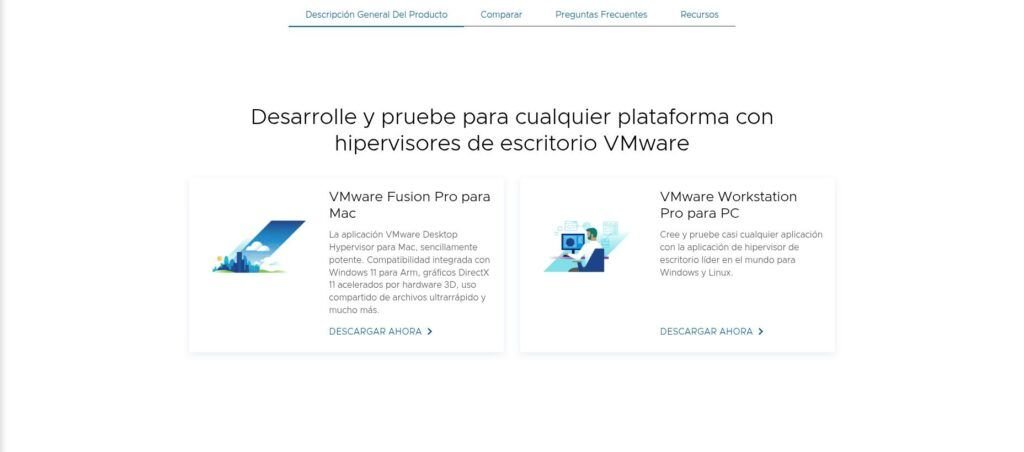
- Visit the official site: https://www.vmware.com/products/desktop-hypervisor/workstation-and-fusion.
- Select Download Now and choose the Linux version (
.bundle). - Requires registration with a VMware account.
7. Installation of dependencies and VMware Workstation Pro.
- Run the following commands to install the necessary dependencies:
$ sudo apt update && sudo apt upgrade -y $ sudo apt install build-essential gcc perl bzip2 dkms make -y $ sudo apt install linux-headers-$(uname -r) -y
- Give execution permissions to the installer:
$ chmod +x VMware-Workstation-Full*.x86_64.bundle
- Run the installer:
$ sudo ./VMware-Workstation-Full*.x86_64.bundle
Extracting VMware Installer...done.
Installing VMware Workstation 17.6.3
Configuring...
[######################################################################] 100%
Installation was successful.After installation, run VMware Workstation with:
$ vmware
If you see any errors related to kernel modules, run:
$ sudo vmware-modconfig --console --install-all
- Follow the graphical wizard to complete the installation.
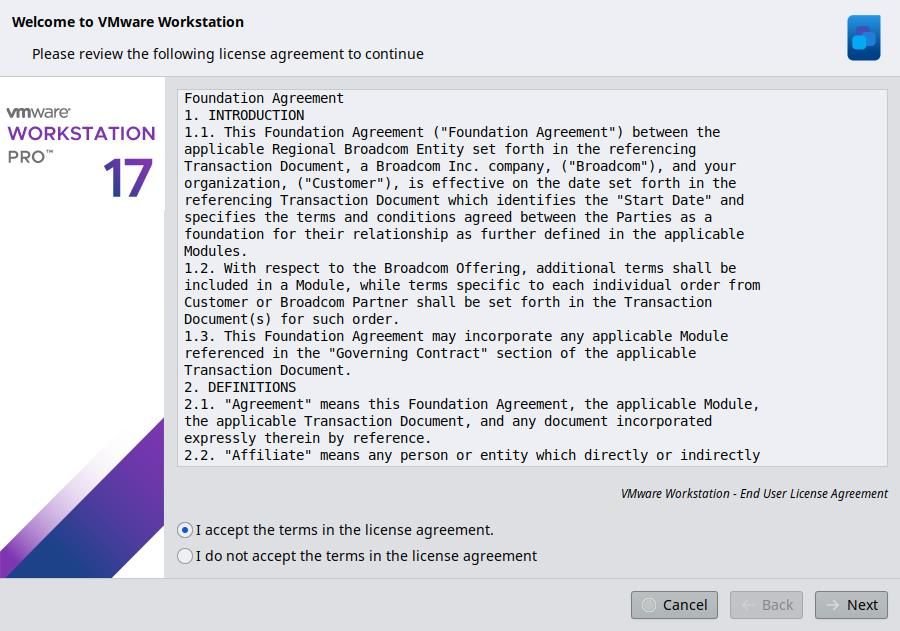
Read the VMWare license and if you agree, accept it and continue with the installation and click the button. Next.
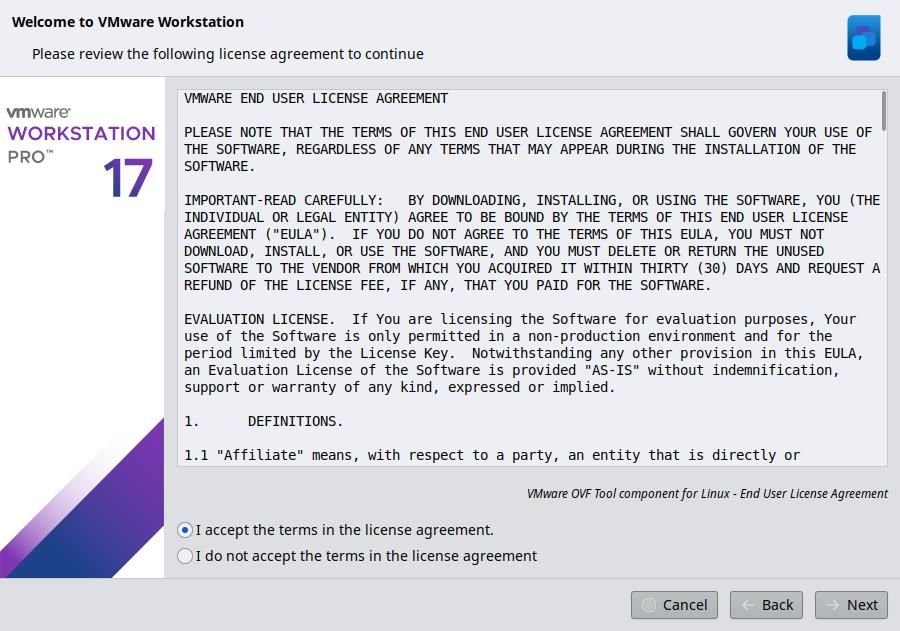
Read the second VMWare license and if you agree, accept it and continue with the installation and click the button. Next.
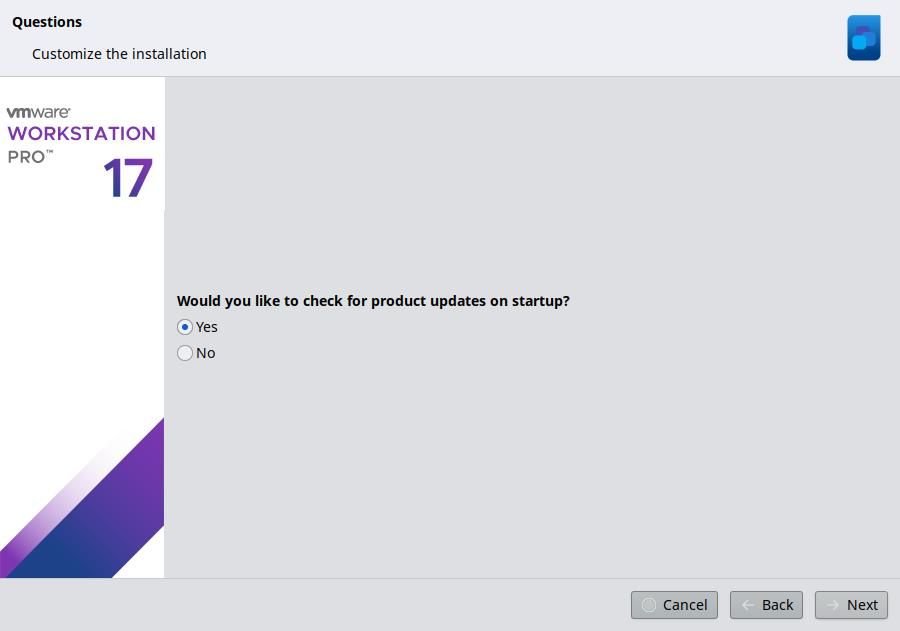
Do you want to check for VMware updates on startup? It tells you FORKS and clicks the Next button.
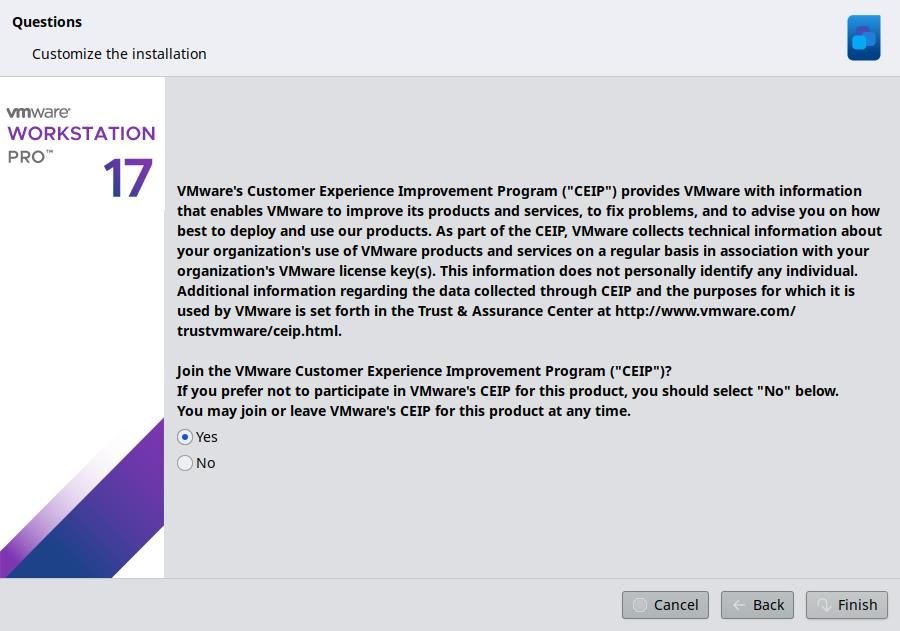
Do you want to join VMware's Customer Experience Improvement Program? Want to help improve its products? Just say Yes and hit Finish.
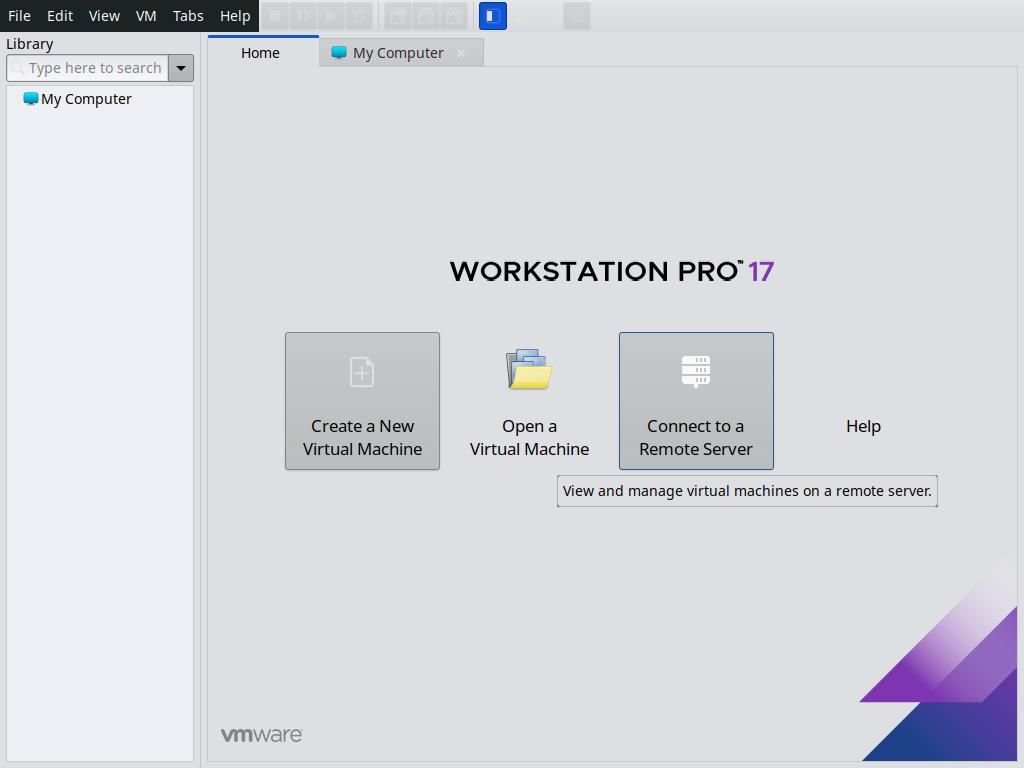
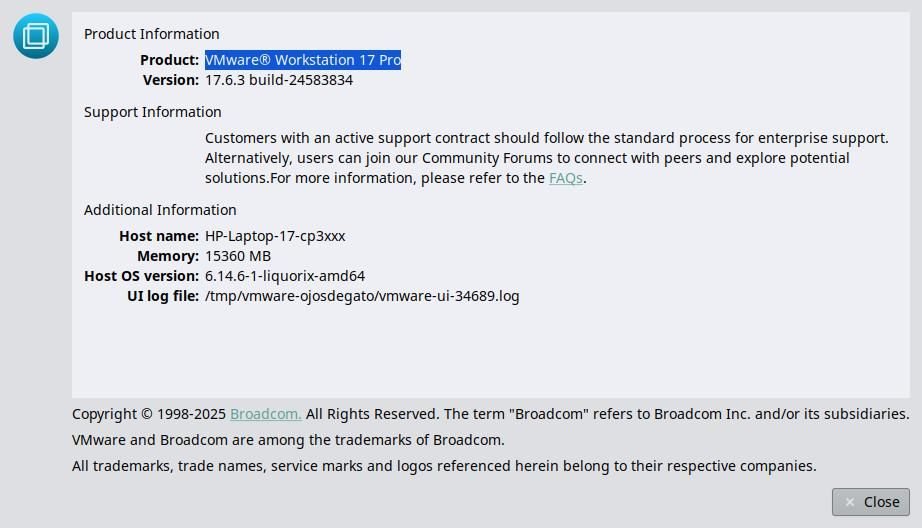
8. Troubleshooting Common Problems
Problem 1: Kernel modules do not compile
"The VMware Kernel modules could not be compiled."
Solution: Missing kernel dependencies or headers.
$ sudo apt update && sudo apt install -y build-essential linux-headers-$(uname -r) $ sudo /usr/bin/vmware-modconfig --console --install-all
Problem 2: USB not working in VM
Mistake: USB devices not detected.
Install libusb:
$ sudo apt install libusb-1.0-0
Restart the VMware service:
$ sudo systemctl restart vmware
Problem 3: Problems with 3D graphics
Mistake: Slow performance or graphical artifacts.
Enable 3D acceleration in VM settings:
VM Settings > Display > Accelerate 3D Graphics
Install graphics card drivers on the physical operating system (NVIDIA/AMD/Intel).
Issue 4: Error starting VMware (GLib-GIO)
«GLib-GIO-ERROR: No settings found…»
$ export XDG_DATA_DIRS=/usr/share $ vmware
9. Conclusion
VMware Workstation Pro is an excellent choice for running virtual machines on Debian 12With the latest version, stability and performance have been improved, making virtualization in Linux environments easier. VMware remains an essential tool for virtualization on Linux. The new free version democratizes access to this technology, allowing more users to take advantage of its benefits without financial constraints.
10. References
- VMware Official Site: https://www.vmware.com
- VMware Workstation 17 Documentation: https://docs.vmware.com
- Installation Guide on Linux: https://kb.vmware.com
- VirtualBox Forums
- KVM Guide for Debian
